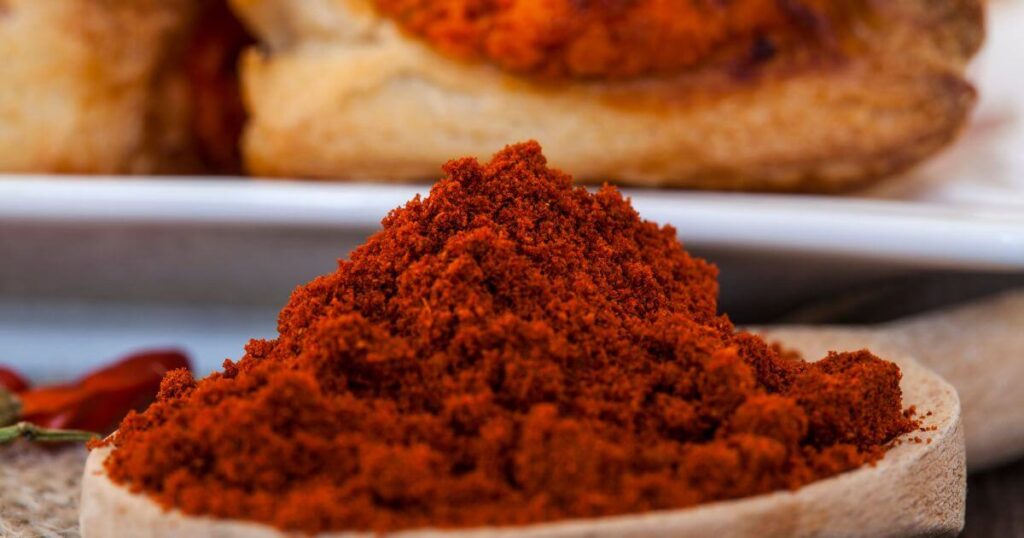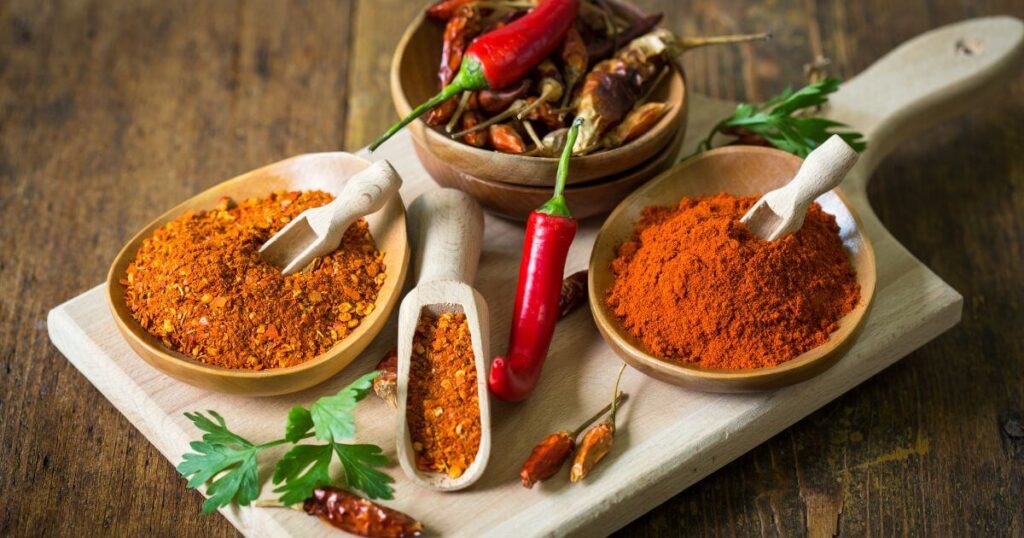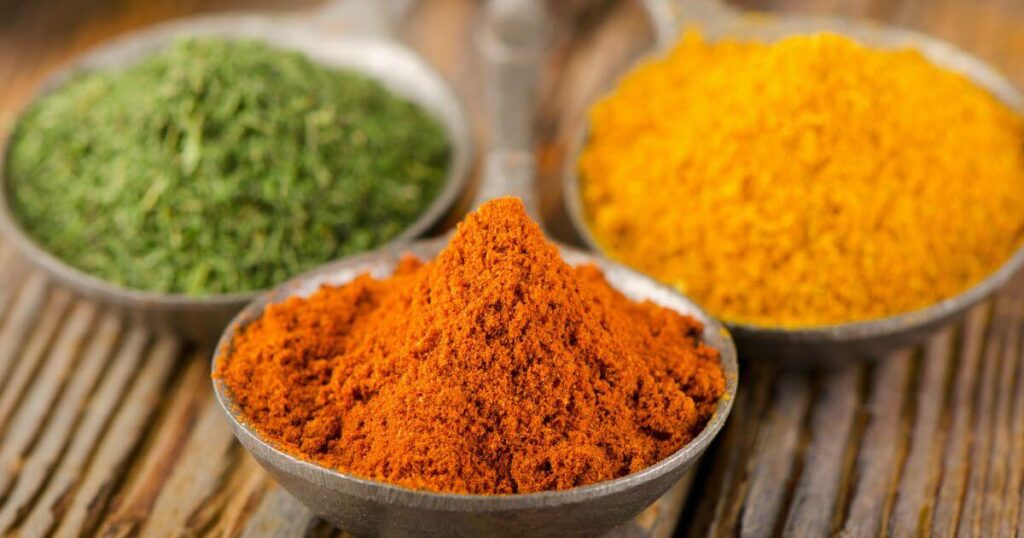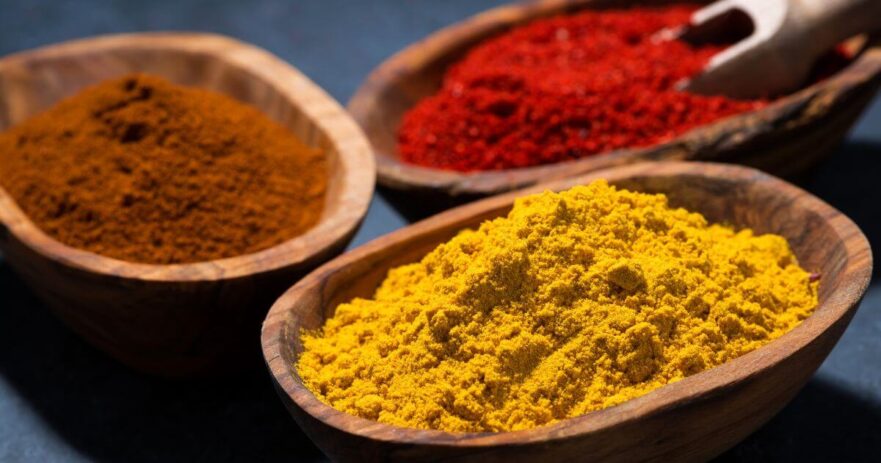In this article about paprika:
🗺️ Origin and history | 🌶️ Uses| 🌶️ Types | ✨ Appearance and taste | 👨🍳 Cooking – recipes | 🛒 Where to buy | 🫙 How to store | 👨⚕️ Health benefits | 🌶️ Alternatives and substitutes | ❓ Frequently asked questions
What is Paprika?
Paprika is a culinary chameleon of the spice rack. Boasting vibrant red hues, Paprika is the product of dried and ground red peppers from the Capsicum annuum family. This vibrant spice offers a unique sweet and spicy balance, making it indispensable in kitchens worldwide.
This spice embodies versatility from the smoked, robust notes of Spanish Paprika to the iconic, deep flavors of Hungarian Paprika. Its unique taste spectrum has secured its spot as an essential ingredient in the culinary arts, with more cooks welcoming its depth and complexity into their creations.
Is Paprika spicy? How hot is it?
Paprika’s spiciness depends on its type and origin. Regular store-bought paprika, typically made from milder peppers, is relatively mild on the heat scale. It has a Scoville heat unit (SHU) rating of 100 to 500, making it at least five times milder than a jalapeño.
On the other hand, Hungarian Paprika, a key element in Hungarian cuisine, offers a broader heat spectrum. While Hungarian sweet Paprika is known for its mild spice, Hungarian hot Paprika ranges between 15,000-60,000 SHU.
Spanish Paprika, though less intricate than Hungarian variants, also presents a range of heat levels. The spice can satisfy different tastes, from mild, to medium, to hot. The smoked variant, another popular choice, comes in mild and hot versions for diverse culinary experiences.
🗺️ ORIGIN AND HISTORY
Where does Paprika come from?
Paprika’s journey started in the fields of Central and South America, its origins steeped in the rich heritage of indigenous peppers. The explorer Christopher Columbus, captivated by these unique peppers, carried them to Spain, thus marking the global onset of Paprika‘s journey.
As European explorers ventured across the world, so did these intriguing peppers, their captivating color and flavor sparking curiosity far and wide. However, Hungary and Spain emerge as two countries where Paprika has deeply influenced their culinary traditions. Hungary fully embraced this vibrant spice, integrating it into their cultural narrative and making it a key ingredient in numerous traditional dishes. Simultaneously, Spain, a nation instrumental in the global dissemination of Paprika, nurtured distinct traditions surrounding this spice.
🌶️ USES

What is Paprika good for? How do I use it?
Paprika, the vibrantly colored spice, is an indispensable ingredient with many culinary applications. Its unique flavor and aesthetic appeal can elevate the simplest dishes to a feast for the senses, making it a favorite among chefs and home cooks.
At its heart, paprika is a versatile spice. Paprika’s robust flavor seamlessly mingles with the savory notes of grilled steaks, barbecued chicken, or slow-cooked pork. It tenderizes the meat while bestowing a warm, earthy aroma, enhancing the overall experience.
Vegetable dishes, too, gain new dimensions of flavor and color with a sprinkle of Paprika. Whether roasting root vegetables or pan-searing a medley of summer veggies, a dash of Paprika provides a subtle, smoky undertone that complements the vegetables’ natural sweetness. It also lends an enticingly deep red hue, making the dish visually appealing.
In the world of soups and stews, Paprika is a game-changer. Its rich, slightly sweet flavor deepens the complexity of broths and bases, infusing a hearty, comforting, and satisfying quality. Whether a robust meat stew or a light vegetable soup, Paprika works its magic by adding an extra layer of flavor.
As a garnish, Paprika’s bright color creates an attractive contrast that appeals to the eye as much as the palate. Be it a light sprinkling on deviled eggs or a generous dusting over potato salad, Paprika adds a pop of color and flavor that enriches the dish. In essence, the uses of Paprika are as varied and diverse as the spice itself, adding value to any culinary creation.
🌶️ TYPES
Diving into the universe of Paprika, we encounter various types primarily rooted in two distinctive culinary landscapes: Hungary and Spain. Each variant carries a unique flavor, color, and pungency, bestowing an abundance of depth to various dishes. Let’s first navigate through the rich tapestry of Hungarian Paprika, where the spectrum ranges from sweet to spicy; each variety has a unique taste and intensity that contributes to the overall palette of Hungarian cuisine.
Hungarian Paprika Flavor Varieties
- ‘Különleges’: With its vibrant, fiery red hue and pleasantly spicy aroma, this Paprika is the finest ground, offering sweet or slightly piquant flavors.
- ‘Csípősmentes Csemege’: This variety, which translates as ‘delicacy without heat,‘ is slightly less finely ground than ‘Különleges.‘ It’s characterized by a light red color, an appealing spicy scent, and an almost non-existent heat, providing sweetness to dishes.
- ‘Csemege’: Not as finely ground as ‘Különleges,‘ this variant stands out for its light red color and pleasant spice aroma. Its taste is predominantly sweet, with a hint of warmth, making it an excellent transitional variety towards slightly hotter Paprikas.
- ‘Édesnemes’: This ‘noble sweet’ Paprika is darker than ‘Csemege.‘ It’s a flavorful, subtly spicy, pleasant taste, and medium grind, representing a middle ground between sweet and spicy Paprika types.
- ‘Félédes’: This ‘half-sweet’ variant is lighter and duller in color than ‘Édesnemes.‘ It’s characterized by a spicy aroma, a pleasantly hot taste, and a medium grind, offering a blend of sweet and mildly spicy flavors.
- ‘Rózsa’: Quite spicy with a red color and medium grind, ‘Rózsa’ sits higher on the heat scale. Its robust and rich flavor indicates a shift towards more pronounced heat, with sweetness receding in the taste profile.
- ‘Csípős Csemege’: This variant can be considered a spicier version of ‘Csemege.‘ It adds an extra kick to dishes, further intensifying their spiciness.
- ‘Erős’: This ‘strong’ Paprika ranges in color from yellow to brownish red. It’s the hottest variant and medium-fine ground, delivering a robust heat for those who love spicy dishes.
After understanding their taste profile, it is equally important to acknowledge the regional variations in Hungarian Paprika. With ‘Kalocsai’ and ‘Szegedi,‘ we pay homage to the regions of Kalocsa and Szeged, both famed for their contributions to the rich heritage of Hungarian Paprika production.
Hungarian Paprika Regional Varieties
- ‘Kalocsai’: Sourced from Kalocsa, celebrated for its role in Paprika production. This variety is most closely associated with the ‘Kalocsa Aranya,‘ ‘Rózsa,’ and ‘Édesnemes,‘ renowned for their exceptional quality. It captivates with its radiant red color, delightful aroma, and a blend of heat levels depending on the variant.
- ‘Szegedi’: Derives its name from the city of Szeged, equally renowned for its Paprika. Historically, only the spiciest variants were produced here. Still, since 1940, it has been associated with the spicy ‘Erős’ and mildly hot ‘Félédes’ Paprika varieties, delivering a taste that beautifully balances heat and sweetness.
As we traverse from the rich flavors of Hungarian Paprika, our flavor journey continues to Spain, another Paprika powerhouse. Spanish Paprika, or ‘Pimentón,‘ is recognized globally for its distinct taste varieties that range from sweet to spicy, including an extraordinary smoky version. Each variant holds a unique allure, demonstrating the versatility of Paprika in global culinary practices.
Spanish Paprika Flavor Varieties
- ‘Dulce’: The gentle sweetness of this variant makes it a versatile ingredient in numerous dishes, lending depth of flavor without any heat.
- ‘Agridulce’: This bittersweet variant balances sweetness and heat, offering a complex flavor that stands out in any recipe.
- ‘Picante’: This variety is for heat enthusiasts, delivering a fiery punch to the palate, turning up the heat in Spanish cuisine.
Spanish Paprika Smoked Varieties
- ‘Smoked Dulce’: This sweet version of smoked Paprika has a delicate smoky flavor that adds a unique dimension to dishes, enhancing their overall flavor.
- ‘Smoked Picante’: This variant marries the spiciness of ‘Picante’ with a deep smoky note, creating a dual sensory experience that is fiery and flavorful.
✨ APPEARANCE AND TASTE
What does a Paprika look like?
The appearance of Paprika is as captivating as its flavor profile. When ground into a fine powder, it boasts a mesmerizing red hue, reflecting the fiery spirit of the peppers it’s derived from. This vibrant color directly results from its high carotenoid content, a class of pigments responsible for the red, orange, and yellow hues in many fruits and vegetables. Although often reduced to a fine powder, Paprika’s visual impact remains undiminished. It instantly elevates the aesthetic appeal of any dish, sprinkling a dash of color that’s as tantalizing to the eyes as it is to the palate.
What does the Paprika taste like?
When it comes to flavor, Paprika truly shines. Its taste is a unique symphony of sweet, smoky, and, at times, spicy notes, which dance on the tongue, each type offering a different culinary experience. Some varieties of Paprika gently tickle your palate with a subtle hint of heat, while others surprise you with a sweet, peppery undertone. Certain types, especially those from Spain, introduce a touch of smokiness, evoking a rustic charm. This rich array of flavors makes Paprika invaluable, capable of leading the flavor parade in a dish or subtly enhancing other ingredients. Despite its humble appearance, Paprika’s flavor always makes a bold statement in the culinary world.
👨🍳 COOKING – RECIPES

Cooking / Recipe ideas for Paprika
Paprika, a radiant red spice, is more than just a garnish sprinkled on deviled eggs or potato salad; it’s a key ingredient that can transform the most mundane dishes into gastronomic delights. Its variants, from the mildly sweet to the tongue-tickling hot, bring a world of flavors to your kitchen.
Hungarian cuisine is unthinkable without Paprika. Imagine a hearty goulash stew bubbling away on the stove, redolent with Hungarian Paprika’s sweet, slightly spicy aroma. This quintessential dish showcases the spice’s versatility. It imparts a rich, red hue to the stew and adds depth to the flavors of meat and vegetables. Hungarian Paprika also breathes life into Chicken Paprikash, another popular dish that lends its mild heat and rich sweetness to a creamy sauce enveloping tender chicken pieces.
Paprika, or ‚Pimentón‘, is integral to the culinary landscape in Spain. Its smoky flavor dances through traditional dishes such as Spanish chorizo, a vibrant sausage marinated in sweet or spicy Paprika, and a symphony of other seasonings. The spice also serves as a vital ingredient in paella, imparting its unique smoky flavor to this rice, meat, and seafood medley.
However, Paprika’s culinary role is wider than these signature dishes. It is also an excellent ingredient for elevating the simplest of meals. For instance, a Paprika-rubbed chicken roast for a weeknight dinner can be a game-changer. The chicken’s skin crisps up beautifully while the meat inside remains juicy, absorbing the complex notes of the Paprika.
In the world of cooking, Paprika is a versatile gem. It can be the primary flavor, a subtle undertone, a vibrant color, or a smoky whisper that ties everything together. Its usage is only limited by your culinary creativity. No matter how it is used, Paprika has the potential to turn every dish into a masterpiece, elevating cooking to new heights of flavor.
🛒 WHERE TO BUY
Where can I buy Paprika?
Finding Paprika is quite straightforward. Your local supermarket typically stocks standard varieties in the spice aisle. Consider exploring specialty food stores for a more diverse range, including Hungarian and Spanish variants. Alternatively, online retailers provide the widest selection of Paprika, offering everything from seeds and plants to processed spice, catering to all your culinary needs.
🫙 HOW TO STORE
How do I store Paprika?
Storing Paprika correctly is crucial to preserving its robust flavor and vivid color. Ideally, keep it in a cool, dark place like a pantry or spice drawer to prevent exposure to heat and light, which can degrade its quality. Remember, while Paprika doesn’t technically spoil, it can lose its potency over time. For the best culinary experience, aim to refresh your Paprika stash every six months, ensuring you always have fresh and potent Paprika at hand for your dishes.
❤️🩹 HEALTH BENEFITS
Is Paprika healthy?
Paprika is not only a versatile spice in the culinary world but also boasts an array of health benefits. It’s rich in essential vitamins, particularly vitamin A, which may contribute to maintaining healthy vision and boosting the immune system.
Furthermore, its capsaicin content, albeit varying across different types, may provide potential health benefits such as promoting better digestion and offering anti-inflammatory properties. So, incorporating Paprika into your diet could be a flavorful way to improve your health.
🔄 ALTERNATIVES AND SUBSTITUTES

What’s a good Paprika alternative?
If your recipe calls for Paprika and you’ve run out, don’t fret. Several suitable alternatives can mimic Paprika’s color, heat, or smoky sweetness, depending on the variety you’re replacing. Here are a few of them:
Consider chipotle chili powder if you want a substitute for smoked sweet Paprika. This powder offers a smoky flavor, although it’s usually hotter than your standard sweet Paprika.
Although it’s considerably hotter, cayenne pepper powder is a good choice for hot or sharp Paprikas. Guajillo pepper powder and chili powder can also serve as substitutes, offering similar heat and color.
For sweet Paprika, ancho pepper powder is a viable option. It provides a sweet and mildly smoky flavor that closely mimics that of sweet Paprika.
Chili flakes, often found in pizzerias, can be a handy replacement, offering color and heat. Keep in mind that the texture may be noticeably different.
For Hungarian Paprika specifically, a good substitute could be cayenne pepper. However, use it sparingly, as it tends to be hotter. If you’re trying to mimic the flavor of sweet Hungarian Paprika, adding a pinch of sugar to these substitutes can bring out a similar sweet flavor.
Ultimately, finding the right substitute depends on your recipe and your taste. Experimentation can lead to some delightful culinary discoveries.
How do you pronounce Paprika?
Paprika is pronounced as puh-PREE-kuh.
🙋 FREQUENTLY ASKED QUESTIONS
FAQ about Paprika
How much Paprika is too much?
The right amount of Paprika depends on the recipe and personal preference. As a spice, it's generally used in moderation. However, using too much can overpower a dish. If you're new to using Paprika, start with a teaspoon or less and adjust to taste.
Are Paprika and smoked Paprika the same?
While both originate from the same types of peppers, the process of creating each differs. Regular Paprika is made by air-drying and grinding red peppers, whereas smoked Paprika involves smoking the peppers over wood fires before grinding, resulting in a unique smoky flavor.
How is Paprika powder made?
Paprika powder is made by drying and grinding various red peppers. The peppers are typically harvested, then air-dried in the sun or by machine before being ground into a powder. The type of pepper used and the drying process can greatly influence the final flavor of the Paprika.
Is Paprika red bell pepper?
Paprika is made from ground, dried red peppers, including varieties such as bell peppers. However, the type of red pepper used can vary, leading to different flavors and heat levels in the resulting Paprika. The peppers used for Paprika are generally sweeter and milder than those used for other chili powders.
Is Paprika or cayenne hotter?
In terms of heat, cayenne pepper is generally hotter than Paprika. Paprika ranges from sweet and mild to moderately hot, depending on the variety. On the other hand, Cayenne pepper consistently brings a high level of heat, making it a potent choice for those who love spicy dishes.

